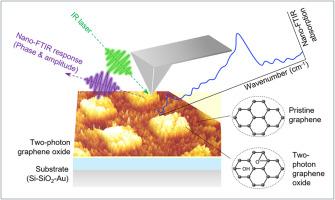双光子氧化石墨烯官能化的纳米ftir鉴定
IF 11.6
2区 材料科学
Q1 CHEMISTRY, PHYSICAL
引用次数: 0
摘要
氧化石墨烯(GO)由于其可调的化学功能和独特的电子特性,在下一代电子、光子和传感技术中发挥着重要作用。然而,在纳米尺度上表征氧化石墨烯的空间和化学异质性仍然是一个持续的挑战,因为传统光谱在解决局部官能团方面存在局限性。对于由飞秒激光诱导的双光子氧化(TPO)修饰的氧化石墨烯来说尤其如此,这会产生空间受限的化学环境,这是本体技术难以解决的。在这里,我们使用傅里叶变换红外纳米光谱(纳米ftir)来实现双光子氧化石墨烯的高度局域化、纳米级化学表征。利用尖端增强光谱,我们用亚衍射空间分辨率解析了关键官能团的振动指纹图谱。纳米ftir分析表明,环氧化物基团主导了氧化过程,在1225 cm−1附近持续出现强烈的振动特征。激光书写参数系统地变化,以了解剂量依赖的氧化行为。通过拉曼光谱、原子力显微镜形貌和与商业氧化石墨烯的比较,验证了所得化学对比。我们的研究结果表明,纳米ftir不仅以前所未有的精度绘制化学非均质性,而且还揭示了非线性氧化动力学。这项工作强调了纳米ftir作为激光诱导石墨烯或其他2d材料的空间分辨化学分析的强大非破坏性工具的实用性。本文章由计算机程序翻译,如有差异,请以英文原文为准。

Nano-FTIR identification of functionalization in two-photon oxidized graphene
Graphene oxide (GO) plays an important role in next-generation electronic, photonic, and sensing technologies due to its tunable chemical functionality and unique electronic properties. However, characterizing the spatial and chemical heterogeneity of GO at the nanoscale remains a persistent challenge, due to the limitations of conventional spectroscopy in resolving localized functional groups. This is especially true for GO modified by femtosecond laser-induced two-photon oxidation (TPO), which creates spatially confined chemical environments that bulk techniques struggle to resolve. Herein, we employ Fourier transform infrared nanospectroscopy (nano-FTIR) to achieve highly localized, nanoscale chemical characterization of two-photon produced GO. Using tip-enhanced spectroscopy, we resolve the vibrational fingerprints of key functional groups with sub-diffraction spatial resolution. Nano-FTIR analysis reveals that epoxide groups dominate the oxidation, with a strong vibrational feature consistently appearing near 1225 cm−1. Laser writing parameters are systematically varied to understand dose-dependent oxidation behavior. The resulting chemical contrasts are validated by Raman spectroscopy, AFM topography, and comparison with commercial GO. Our findings demonstrate that nano-FTIR not only maps chemical heterogeneity with unprecedented precision but also reveals nonlinear oxidation dynamics. This work highlights the utility of nano-FTIR as a powerful non-destructive tool for spatially resolved chemical analysis of laser-induced graphene or other 2D-materials.
求助全文
通过发布文献求助,成功后即可免费获取论文全文。
去求助
来源期刊

Carbon
工程技术-材料科学:综合
CiteScore
20.80
自引率
7.30%
发文量
0
审稿时长
23 days
期刊介绍:
The journal Carbon is an international multidisciplinary forum for communicating scientific advances in the field of carbon materials. It reports new findings related to the formation, structure, properties, behaviors, and technological applications of carbons. Carbons are a broad class of ordered or disordered solid phases composed primarily of elemental carbon, including but not limited to carbon black, carbon fibers and filaments, carbon nanotubes, diamond and diamond-like carbon, fullerenes, glassy carbon, graphite, graphene, graphene-oxide, porous carbons, pyrolytic carbon, and other sp2 and non-sp2 hybridized carbon systems. Carbon is the companion title to the open access journal Carbon Trends. Relevant application areas for carbon materials include biology and medicine, catalysis, electronic, optoelectronic, spintronic, high-frequency, and photonic devices, energy storage and conversion systems, environmental applications and water treatment, smart materials and systems, and structural and thermal applications.
 求助内容:
求助内容: 应助结果提醒方式:
应助结果提醒方式:


